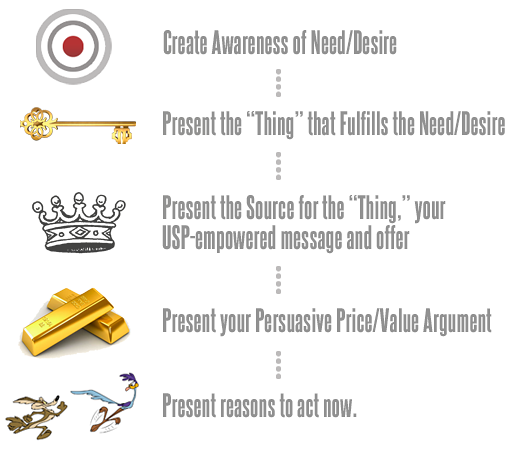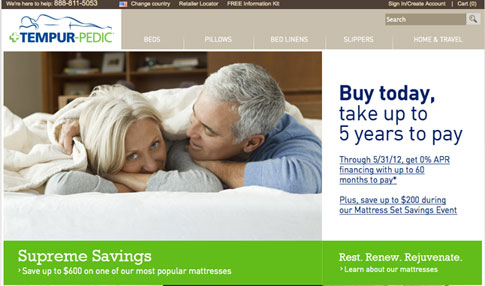If you were to go outside and ask different people what marketing is, you might get a lot of different answers. Some people might say to ?sell a product,? others might say it?s about ?building brand awareness,? others might say it?s advertising through mass media.
Marketing is really about persuading people to take action: to fill out a form, accept your proposal, register for your newsletter, or make a purchase. In order to persuade, you must communicate your message clearly. Your advertising, whether it?s in print or on the web, will be more effective if it?s well-organized.

Jordan Belfort, the self-styled ?Wolf of Wall Street,? currently has a movie being produced about his life by the same name, starring Leonardo DiCaprio. In his sales trainings, he teaches a very simple ?straight-line? process to a sale or action decision, from open to close.
The Direct Marketing Matrix is a simple ?straight-line? structure that we?ve developed for creating advertisements that lead the prospect to a buying or acting decision, from open to close. Sometimes you start at step 1, other times you get to start at step 2. A company selling baby food gets to start at step 2. A company selling baby vitamins has to start at step 1.
Now let?s look at all 5 pieces of the matrix in greater detail.

1. Create awareness of the need/desire
Virtually all advertising skips this step, and skips straight to skip 3. Most businesses simply advertise their existence, or existence plus benefits.
This is a mistake. Pushing of product is just clutter in an already over-communicated world.
I could be watching late night television, and not be aware that I need a super deluxe, state of the art electronic mattress that massages my sore, overworked spine while I sleep. But once an infomercial makes me aware of the potential health hazards caused by a traditional mattress, I?m much more open to seeking out a solution to the problem, and being receptive to the product.
Another example might be: ?Don?t let your financial security be stolen from you because of a simple investment mistake!?
If this above example were a real headline for an ad piece, then you would want to make it much more specific to make it more effective. For example? you might start the headline by mentioning your target market with ?Baby boomers: Don?t let your financial security?? or ?Retirees??
This lets your target market know that what you?ve got is for them, and makes the headline (and advertisement) much, much more effective. Also, you?d want to be more specific about the nature of the ?mistake,? the more specific you are, the better.
2. Present the ?thing? that fulfills the need/desire
The next step in your ad is to present the solution that scratches the itch.
If you?re an internet marketer who works for clients, you might say: ?Online marketing is an effective, cost-efficient alternative to traditional marketing.?
- Who else says so besides you? This is the time to let me know. Client testimonials can never be over-used and give me reasons to believe that what you tell me is the truth. You can create entire ads just based around 3rd-party testimonials, and many marketers do.
- Third-party sources such as press and publications can verify your claim and give it credibility. Dig up some statistics that lend credence to your statements with laser-like clarity and focus.
Over 50% of all marriages end in divorce, according to Psychology Today? If you?re a marriage therapist, let your prospects know about the bare truth of marriage and the positive effects of therapy.
Step 2 is to present your service as a viable, effective, credible solution to the problem identified in step 1. Marriage therapy is an antidote to divorce. Chiropractic is a safe non-surgical treatment for various back and body problems. Solar panel installation is an alternative energy solution that saves money and pays for itself within a few short years.
You get the idea.
3. Present the source (you) for the ?thing,? and deliver your USP-empowered message, and offer
An example: ?ABC Pest Control provides an environmentally-sound, green-friendly bug zapping service. Locally-owned for 15 years. Satisfaction is guaranteed for every customer or double your money back.?
Another basic example, but you get the idea. Most great businesses put forth great selling propositions, or try to. When Tempur-pedic says ?Buy today, take up to 5 years to pay? on their website, they?re delivering a USP designed to drive sales of their mattresses.

If you?re struggling to write a USP, here are five good ways to start coming up with ideas.
First, think about how you sell your product or service if you were talking to a prospect face to face, or over the phone. Then think about how you can add to your USP by: increasing the perceived value of your offering; improving the experience of the customer; making it safe to buy through guarantees, and eliminating resistance to buying; and what you can offer to the prospect in the form of incentives, or promotions.
To start, get out a sheet of paper and write down every benefit, promise, feature, fact, idea that you can think of about your business and competitors. Then do your best to prioritize the items in order of their probable importance to your customer. Through this exercise, you can develop a strong USP and related offers.
For additional information on this topic, see this blog post about unique positioning.
4. Present a persuasive price / value argument
Don?t skip over this step, as this is critically important to get right to maximize your sales/profits. For example, direct marketing research indicates that, for affluent target markets, stacking value to your sales proposition can be more persuasive than offering a discount of equal amount.
A simple example might be something like: ?Free airfare, hotel, lodging, and meals are included when you register for this 3-day seminar.?
Translate the value into terms your prospect can understand. There?s a million ways to do this and it could be the topic for entire post. Present specific benefits, such as time or money saved through the purchase of the product.
5. Present reasons to act now.
The goal of the last step is to light a fire under the prospect?s derriere and get them to order now. So, if you were promoting your marketing services to a target niche, you could say: ?This message is urgent and has been sent to all of your competitors.?
That?s dirty pool. And great marketing ? street marketing, at it?s finest.
- Present multiple calls to action on every ad, every e-mail, or on every web page. The difference between a professional salesman and a professional visitor is as simple as asking for the order. Zig Ziglar, the great salesman and motivational speaker, was fond of saying: ?Timid salespeople have skinny kids.?
- Ask for action in the copy, in the form of a ?bright shiny offer? graphic or button, in bulleted ?benefits,? in blue hyperlinks, in the P.S. of your message, etc.
- Most businesses do not include calls to action in their marketing messages. There is no offer ? simply an implied offer. If you need us, here?s our number. You?re not psychic, and chances are your prospect isn?t either: so clearly communicate the next step to them.
One final thought about step 5.
You?ve done a great job leading your prospect to make an action or a buying decision, so why lose the sale at the last moment? People do change their mind at the last second, often, and you have to be ready for this. We?re naturally un-trusting people in an un-trusting society. Each of us has been lied to, cheated, or manipulated in some way or some how in the past by some one. At the point of sale, make it very safe to buy. Make the transaction profitable for the customer even if the product fails.
In summary
Here?s an instructive exercise: open the Yellow Pages, or look at the list of small businesses advertising via PPC on Google. Do the ads present their messages in an organized structure similar to this? Most don?t, and that?s a big mistake.
So there you have it.
An effective, easy-to-implement structure for creating direct marketing ads that sell. Remember, to improve the effectiveness of your ads: focus on creating multiple USPs, offer propositions, and calls to action that are highly desirable to your prospect. Your offers, USPs, etc. should be highly targeted to your market.
For example, if selling skin care products to moms, stating that it?s ?Doctor approved? is a motivational message. But for teenage girls, it?s more about getting rid of that zit because it prevents them from going out with their friends to the movies, prom, etc.
Good luck, and keep on. Don?t stop until your marketing is scary good, and your business highly profitable.
Want to get in touch with me? Leave a comment below this post and I?ll respond promptly.
Danny Flood is the co-founder of LavaLink, and the brainchild behind this website. He has been an online marketing consultant for hundreds of small businesses and entrepreneurs, and is a frequent speaker on wordpress design and web marketing topics.
nba trade rumors 2012 ncaa tournament schedule laurent robinson dantoni gillian anderson leah remini desean jackson
No comments:
Post a Comment
Note: Only a member of this blog may post a comment.